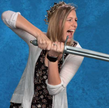 Mrs. Opperman Thespian Director The 2016-2017 school year marks not only WCA’s induction into the world of theater, but also the world of theater related competitions. Many people think that competing is only for the actors. This, however, is a misnomer. In fact, the world of competition for International Thespians spans from acting, to costuming, to technical skills (including sound, lighting, props, and set dressing), production, and writing. Basically, there is something for everyone who is interested in the competition world of ITS that does not involve monologues and auditions. Below is a quick breakdown of the types of skills that will be tested at the upcoming Cal Thespian Festival in late March: Acting – Monologues In Acting – Monologues, the skills measured are: • Use of transitions into and out of character • Ability to create a believable character • Communication of objective, tactics, and relationships • Use of focus and concentration • Integration of voice, body, movement, and staging Acting – Duo/Group Scene A duo is defined as a performance for two players. A group scene is defined as a performance for three to sixteen players. In each case, every participant must be actively involved in the scene chosen for performance. In Acting – Duo/Group Scene, the skills measured are: • Use of transitions into and out of character • Ability to create a believable character • Communication of objective, tactics, and relationships • Use of focus and concentration • Integration of voice, body, movement, and staging Musical Theatre – Solo Performance In a musical theatre solo performance, the entrant must present one musical selection from a published script written for musical theatre. The judges will consider how well the piece is acted, not only how well it is sung. The selection may contain dialogue; however, this is primarily a “sung and not spoken” selection Musical Theatre – Duet/Group Performance In a musical theatre duet/group performance, the entrants must present one musical selection from a published script written for musical theatre. The judges will consider how well the piece is acted, not only how well it is sung. The selection may contain dialogue; however, this is primarily a “sung and not spoken” selection. A musical theatre duet is defined as a musical theatre performance for two players. A musical theatre group scene is defined as a musical theatre performance for three to sixteen players. In each case, every participant must be actively involved in the scene chosen for performance. In Musical Theatre – Duet/Group Performance, the skills that measured are: • Use of transitions into and out of character • Ability to create a believable character • Communication of objective, tactics, and relationships through dialogue and music • Use of focus and concentration • Vocal skill and technique • Use of dance and movement • Integration of voice, body, movement, and staging Costume Construction In Costume Construction, the skills measured are: • An understanding of the role of costume construction • Sewing and construction skills • The ability to present and explain the process of constructing the costume • Attention to detail Lighting Design In Lighting Design, the skills measured are: • An understanding of the roles and responsibilities of a lighting designer and the technology/equipment to implement and support the design • The ability to present and explain design choices • An understanding of the artistic and practical constraints that impact lighting design • An understanding of the relationship of lighting design to a unifying concept • The ability to carry out research into style, period, locale, and genre of the show Scenic Design In Scenic Design, the skills measured are: • An understanding of the scenic designer’s role and responsibilities • An understanding of the artistic and practical constraints that impact the scenic design • An understanding of the relationship of scenic design to a unifying concept • The ability to carry out research into style, period, locale, and genre of the show • The ability to present and explain design choices Sound Design In Sound Design, the skills measured are: • An understanding of the roles and responsibilities of a sound designer and the technology/equipment to implement and support the design • An understanding of the artistic and practical constraints that impact the sound design • An understanding of the relationship of sound design to a unifying concept • The ability to carry out research into style, period, look Stage Management In Stage Management, the skills measured are: • An understanding the stage manager’s role and specific responsibilities • An understanding of the purpose and value of a production book • The ability to organize stage management ideas, products, and choices that support a realized production Theatre Marketing In Theatre Marketing, the skills measured are: • An understanding the marketing director’s role and specific responsibilities • An understanding of the purpose and value of research, resources, and personnel needed to communicate a marketing concept to an audience • The ability to align a marketing campaign’s components in a distribution strategy that supports a realized production Short Film In Short Film, the skills measured are: • The ability to create opening and closing titles, credits, and graphics that orient the viewer to the story • The ability to visually develop a story with dialogue • Camera, lighting, and sound use • Editing, including scene length and flow • The emotional and physical believability of the acting • The filmmaker’s use of film elements to create a successful product For more information on competitions, please visit the ITS website at https://www.schooltheatre.org/home
0 Comments
Leave a Reply. |
AuthorWCA's Thespian Officers welcome you to "To Blog or Not to Blog" where our wacky troupe thrives. Archives
September 2018
Categories |
 RSS Feed
RSS Feed
